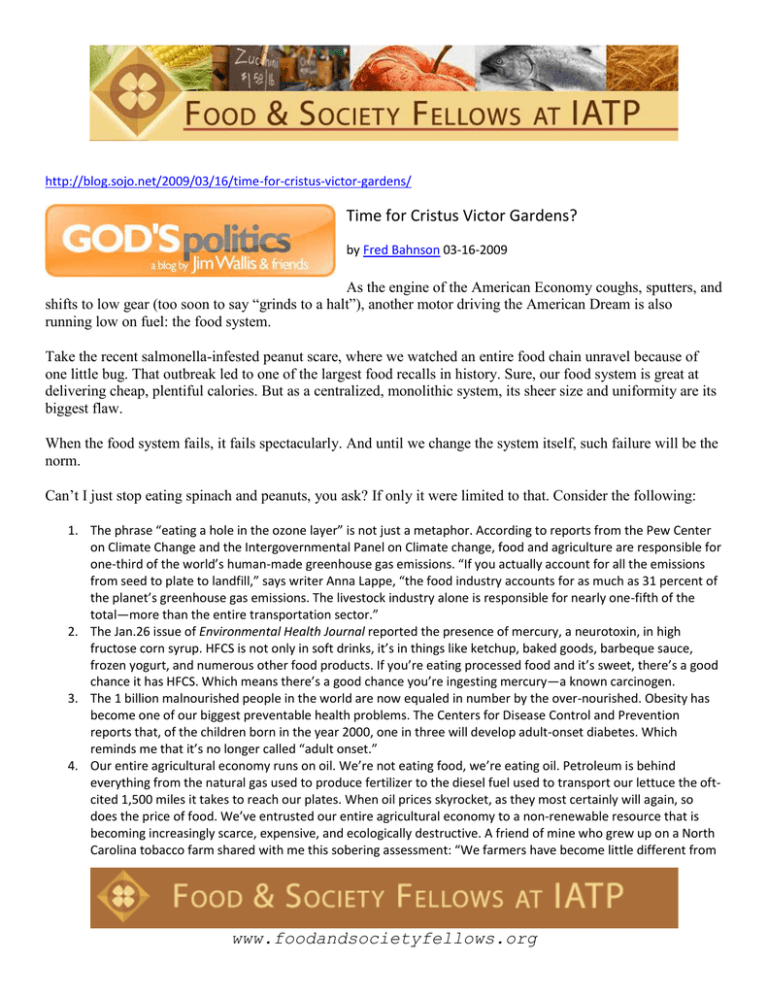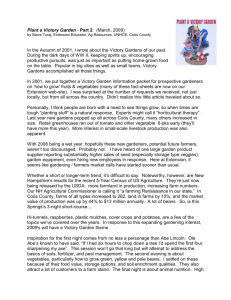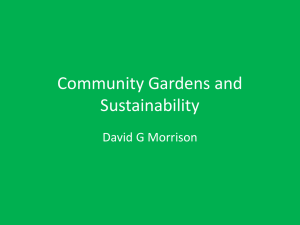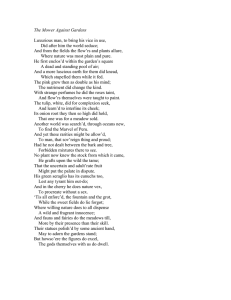Time for Cristus Victor Gardens?
advertisement

http://blog.sojo.net/2009/03/16/time-for-cristus-victor-gardens/ Time for Cristus Victor Gardens? by Fred Bahnson 03-16-2009 As the engine of the American Economy coughs, sputters, and shifts to low gear (too soon to say “grinds to a halt”), another motor driving the American Dream is also running low on fuel: the food system. Take the recent salmonella-infested peanut scare, where we watched an entire food chain unravel because of one little bug. That outbreak led to one of the largest food recalls in history. Sure, our food system is great at delivering cheap, plentiful calories. But as a centralized, monolithic system, its sheer size and uniformity are its biggest flaw. When the food system fails, it fails spectacularly. And until we change the system itself, such failure will be the norm. Can’t I just stop eating spinach and peanuts, you ask? If only it were limited to that. Consider the following: 1. The phrase “eating a hole in the ozone layer” is not just a metaphor. According to reports from the Pew Center on Climate Change and the Intergovernmental Panel on Climate change, food and agriculture are responsible for one-third of the world’s human-made greenhouse gas emissions. “If you actually account for all the emissions from seed to plate to landfill,” says writer Anna Lappe, “the food industry accounts for as much as 31 percent of the planet’s greenhouse gas emissions. The livestock industry alone is responsible for nearly one-fifth of the total—more than the entire transportation sector.” 2. The Jan.26 issue of Environmental Health Journal reported the presence of mercury, a neurotoxin, in high fructose corn syrup. HFCS is not only in soft drinks, it’s in things like ketchup, baked goods, barbeque sauce, frozen yogurt, and numerous other food products. If you’re eating processed food and it’s sweet, there’s a good chance it has HFCS. Which means there’s a good chance you’re ingesting mercury—a known carcinogen. 3. The 1 billion malnourished people in the world are now equaled in number by the over-nourished. Obesity has become one of our biggest preventable health problems. The Centers for Disease Control and Prevention reports that, of the children born in the year 2000, one in three will develop adult-onset diabetes. Which reminds me that it’s no longer called “adult onset.” 4. Our entire agricultural economy runs on oil. We’re not eating food, we’re eating oil. Petroleum is behind everything from the natural gas used to produce fertilizer to the diesel fuel used to transport our lettuce the oftcited 1,500 miles it takes to reach our plates. When oil prices skyrocket, as they most certainly will again, so does the price of food. We’ve entrusted our entire agricultural economy to a non-renewable resource that is becoming increasingly scarce, expensive, and ecologically destructive. A friend of mine who grew up on a North Carolina tobacco farm shared with me this sobering assessment: “We farmers have become little different from www.foodandsocietyfellows.org Wall Street bankers. We just keep running up credit, mortgaging the future on fossil fuels and techniques that may pay off in the short run but that are ultimately going to collapse.” So much for sputtering engines. The pressing question is, ‘What can the church do?’ We can begin by acknowledging that food is our most basic relationship with creation. When we eat we are swallowing a piece of God’s world. Would we swallow with more care if we thought of our food and the soil that grew it as a sacrament — that is, as a means of grace? If we confess that the church is Christ’s body present in the world, isn’t it time that we asked some hard, prophetic questions about what exactly we’re ingesting? About how we’re growing all that food and what it’s being used for? How can we pray “Thy kingdom come, Thy will done done on earth” while we’re polluting that same earth with our agricultural chemicals and carbon dioxide? How can we “glorify Christ in our bodies” while we sip neurotoxin-laced soft drinks and turn our children into diabetics before their 10th birthdays? Isn’t it time we weaned ourselves from an industrial, oil-dependent, gluttonous food system that’s overfeeding us as it ruins our land, air, and water? Isn’t it time we replaced it with one that treats the soil as God’s good gift that we’re entrusted with “serving and preserving” (Genesis 2:15)? We can’t wait on the government. The church needs to create the change it wants to see. And that means growing our own food. Yes, growing our own. It wouldn’t be the first time. During World War II, victory gardens supplied 40 percent of the nation’s food. What if we again planted such victory gardens, thousands upon thousands of them, and not just in our backyards but on our church lawns? Instead of calling them “victory gardens,” a WWII-era name still redolent of American military, we can call them “Cristus Victor” gardens. To plant a community garden is to immediately address, even if only in small ways at first, each one of those problems previously mentioned. Because the food would be grown locally (don’t have to ship it) and would use sun power instead of oil power (no oil-based pesticides or fertilizers allowed), we would simultaneously decrease our carbon footprint and our dependence on a non-renewable resource. That community garden would also give us exercise, a much-needed antidote to obesity and diabetes. It would connect us with both neighbors and strangers. And lastly it would give us fresh, healthy produce that not only tastes better than anything you’d find at Piggly Wiggly, but we would know how it was grown. Which can’t be said for most of what we currently swallow — peanuts or otherwise. Fred Bahnson is director of Anathoth Community Garden in Cedar Grove, North Carolina, and is a Kellogg Food & Society Policy Fellow. His essays have appeared in Orion and The Best American Spiritual Writing 2007. www.foodandsocietyfellows.org







